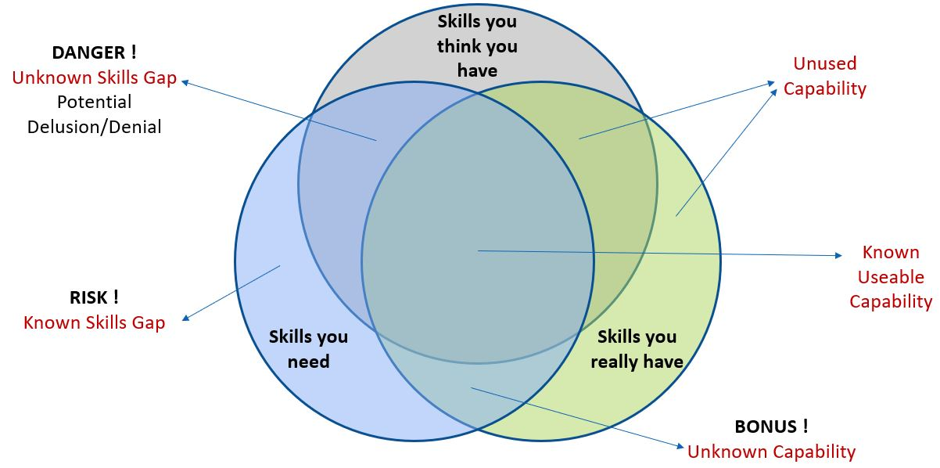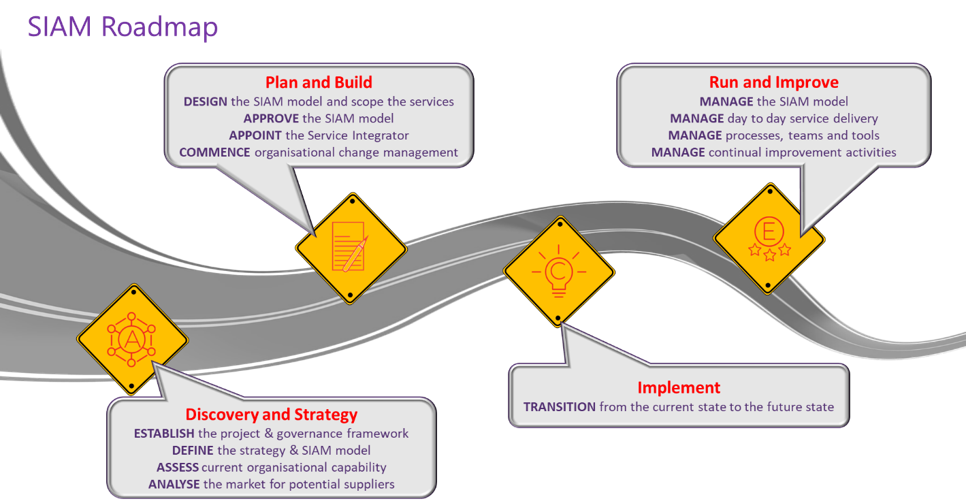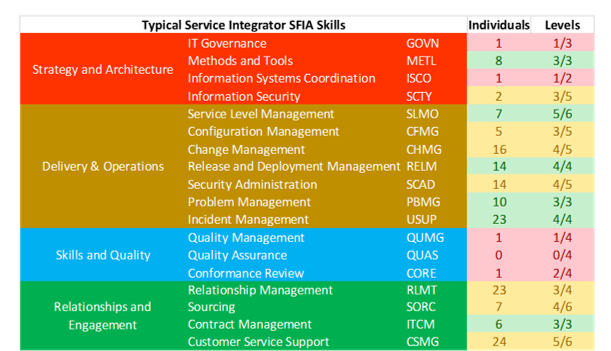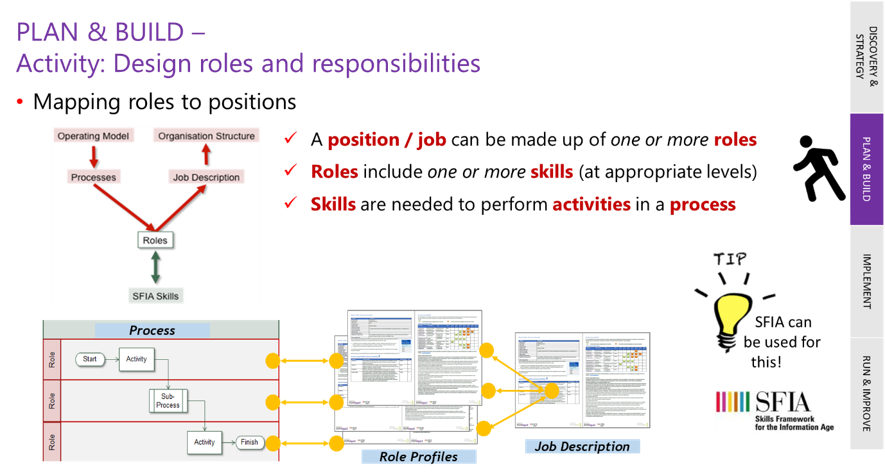During the original authoring and the recent updates to the Service Integration and Management (SIAM) Bodies of Knowledge (BoKs), within the authoring team we have discussed how far to go within each of the BoKs, and where some additional content may be useful outside of the core volumes.
We included some general guidance on how to approach the people and skills aspects when defining and operating a SIAM model, but the reality is that each organization will be slightly different, and therefore we stopped short of providing a fully defined set of role profiles and required skills for those performing each of the roles.
Common Position
The certainty for all those designing, implementing or operating any type of operating model, including SIAM-based models, is that none of them will work well-enough unless they have the right people, with the appropriate skills and experience. People, and their skills and experience, are essential!
The reality for most organizations is that they don’t really know what skills they have. Many of their failures are caused by thinking they have skills that they don’t really have, or not knowing that others in different roles within the organization have the skills they need, but are not being given the opportunity to apply them.
You can’t expect to be successful if you simply “hope” that things will work out. You need to know exactly what you have, what you need, and what your gaps are – a data-driven approach to ensure you recruit, develop and retain your most valuable assets – your people!
The Truth
I’ve spent the last 20+ years helping organizations to confirm what skills they have, which skills they need, and how to close the skills and experience gaps and risks. Whether you’ve assessed it or not, you may have a view on the skills you have in the organization – however, as many studies by industry analyst have shown, most companies haven’t got an accurate inventory of their current skills. In my experience, for every company, the skills they really have are different from what they thought they had. Then, of course, you need a view on what skills you need.
Here’s what we generally find:

• There’s the good stuff in the middle – your known useable capability
• You have the bonus of the unknown capability – skills you didn’t know you had, that you need and therefore could utilise.
• You have the known skills gaps, which present a risk.
• But even more dangerous, are the skills you thought you had, but don’t. These often are the skills that cause the outages, security breaches and other issues.
• The unused capability will probably include skills that you will need in a few months’ time.
• It’s essential to have this complete picture, as you can make better decisions about the skills you develop, the ones you recruit or source from outside, and the risks you accept.
Many companies approach this in a way which starts with the current roles/jobs, and they only ask the workforce about those skills – you don’t get the complete picture that way, and you are almost certain to get skewed and inaccurate data.
Getting the people and skills elements right
There are several critical points during the SIAM roadmap where the people and skills aspects need careful thought.

Putting to one side, for the moment, the need to understand where you are starting from (your current skills inventory – which is my suggested starting point), let’s look at the decisions you make when deciding the right SIAM operating model for the organization.
In general, this is about agreeing roles and responsibilities, and ensuring that these are designed down to the level to confirm the skills and levels of skills needed by each role in order to fulfil the defined responsibilities.
Definitions:
• Role: “the position or purpose that someone or something has in a situation, organization, society or relationship”
• Responsibility: “something that is your job or duty to deal with”
I’d like to highlight four main activities related to roles and responsibilities. The first is during the “Discovery & Strategy” stage, where the definition of principles and policies are critical for the design of an effective SIAM ecosystem. It is essential that the roles and responsibilities are mapped at this point, agreeing how they all fit together. With the roles and responsibilities agreed, the skills and levels of skills/experience required for each role can be identified. This allows skills comparison against existing positions, to get a view on potential skill gaps and development needs, as well as skills which some people may not get the opportunity to practice in their new roles because of the changes in responsibilities. This high-level analysis will be an input to the strategy, and the final mapping will change depending on the SIAM model chosen. The following is an example of typical Service Integrator skills, using SFIA (the Skills Framework for the Information Age) as the common international language for describing skills.

During the “Plan & Build” stage, the design of role profiles can be completed, including allocation of responsibilities to roles. The roles can also be mapped to positions/jobs, as often an individual position/job may include several roles across multiple processes. As an example, a Service Desk Manager position/job may include roles such as Major Incident Manager, Incident Management Process Owner, Application Support Manager – each role with a distinct set of responsibilities and a differing set of required skills.

The specific design of the roles and responsibilities that will be right for your organization, will depend on the target SIAM model selected, the optimum combination of roles into positions/jobs based on the workload and skills required for each role, as well as the detail of the process flows within the SIAM framework. Other factors such as segregation of duties may influence which roles cannot be combined into a position/job. Performing this mapping will assist with training needs analysis and sourcing strategies.
During the “Implement” stage, the allocation of roles and responsibilities to organizations and individuals is confirmed. The Customer entity may have to retain some roles due to legislation or regulation. The Service Integrator will be accountable for service governance, performance management, integration, assurance and coordination. Service Providers will fulfil service delivery roles. At this point, assuming you have baselined the current skill profile of each person, the individuals can compare their skill profile with the requirements of roles/jobs/positions and create structured and prioritised development action plans.
During the “Run & Improve” stage, monitoring and improvement, including the maintenance and updating of development action plans, which ensure people focus on the required skills and gain necessary experience. There is almost always some sort of cultural and behavioural change required. Some parties will transition from being a ‘Customer’ to a ‘Service Provider’ and/or ‘Service Integrator’. The focus may shift from operational to strategic, from managing activities to managing outcomes, from the ‘what’ to the ‘how, and from a siloed to a more collaborative approach.
Takeaways:
• Find out where you’re starting from! Answer the “what skills do we have” question. You need a complete skills inventory, as you’ll find skills that you already have in your organization which you didn’t know you had and are therefore not yet using.
• Agree what you need! Define your operating model, the processes to be followed and the roles involved in performing the tasks. Then take it a step further, and list the skills and levels of skill required for each role, defining the essential and desirable skills that anyone would need to be able to adequately perform the role.
• Take appropriate development actions! Compare the skills of an individual with the skills required for their current and/or future role, and help them build a structure development action plan which addresses at least the essential skill gaps.
• Maintain and use your data:
o For each individual, ensure they keep their skill profile up-to-date as they develop new skills and experience, and complete the actions in their development action plan.
o For each role, ensure that the role profiles evolve when needed to support continual improvement and any changes in requirements or in the operating model.

About the Author
Matthew Burrows is a past President of the Institute of Service Management, contributor to service management and project management standards and publications (including the SIAM Bodies of Knowledge), member of the SFIA Council and the Global Design Authority for SFIA (the Skills Framework for the Information Age).
An internationally-recognised thought leader, SFIA Accredited Consultant and Trainer, Matthew works with companies and governments to improve Digital Skills Management maturity, and how to attract, develop and retain Digital, ICT, Cybersecurity and other technology-focussed professionals.



